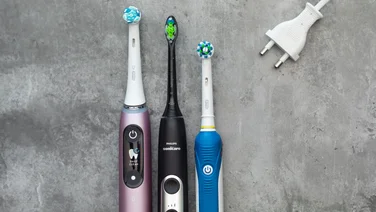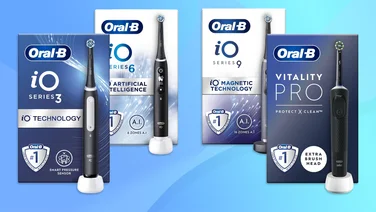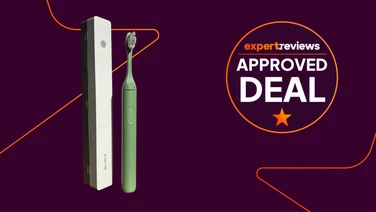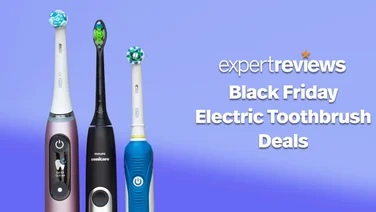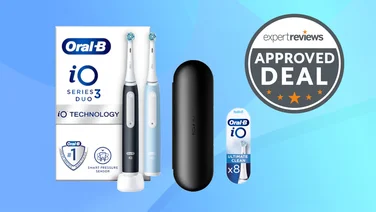To help us provide you with free impartial advice, we may earn a commission if you buy through links on our site. Learn more
- What is an electric toothbrush?
- Why should you clean your electric toothbrush?
- Daily cleaning tips for your electric toothbrush
- Weekly cleaning tips for your electric toothbrush
- How to store your electric toothbrush
- UV toothbrush sanitiser
- When should you replace your electric toothbrush head?
- Are electric toothbrushes better than manual ones?

Dentists recommend using an electric toothbrush to help keep our teeth healthy, clean and free of plaque. But while you’re busy taking care of your teeth with the best electric toothbrushes, have you ever stopped to think about how to take care of the toothbrush itself?
Unlike manual versions, electric toothbrushes are designed to last for years. So knowing how to clean them properly is vital.
What is an electric toothbrush?
Electric toothbrushes use rechargeable batteries to allow the bristles to oscillate and clean your teeth. There are two main types – with the most common having small, round heads that oscillate at high speed, rotating either back and forth or alternating between a clockwise and anticlockwise direction.
The other type of electric toothbrush is a sonic or ultrasonic brush with heads that vibrate very quickly at frequencies that break up plaque and force toothpaste between the teeth for a deeper clean. Electric toothbrushes sit on their chargers when not in use, with power usually being provided by a shaving socket in the bathroom. Modern batteries can provide two to four weeks of brushing between charges.
Why should you clean your electric toothbrush?
“Electric toothbrushes are an excellent way to maintain your oral health but it’s important that they stay clean and bacteria-free,” explains Oral-B’s dentist Dr Vikas Prinja. The germs you can’t see on your toothbrush are the ones you need to be dealing with. Our mouths are full of microscopic bacteria and when we remove this from our teeth, gums and tongue, it gets transferred to our toothbrushes. This is why it’s so important to clean your electric toothbrush as well as your mouth. (Please note: make sure to unplug it from any charger before cleaning.)
READ NEXT: Best Oral-B toothbrushes
Daily cleaning tips for your electric toothbrush
“After brushing your teeth, immediately rinse your brush under warm water for 5-6 seconds with the head on,” recommends Dr Prinja. “Then decouple the toothbrush head from the toothbrush and rinse each part separately, making sure to rinse the undersides. If there’s a lot of residue, it’s okay to use a mild detergent or cleanser on the outside of the handle.”
Rinsing your toothbrush in hot water helps sanitise it and get rid of any bacteria that’s accumulated as you brush. Using hot water is also the easiest way to get rid of any dried-on toothpaste as the warmth and steam helps to break it all down.
Once you’ve rinsed your toothbrush thoroughly, Dr Prinja recommends that you wipe it dry with a clean cloth or towel and gently tap it on the sink to help remove any residual water. Finally, store the handle and toothbrush head separately until dry, in a cool area away from moisture.
Weekly cleaning tips for your electric toothbrush
As well as daily cleaning, there are several deeper cleaning routines that we’d recommend introducing to ensure your toothbrush stays healthy and hygienic for longer. You don’t have to use all of these – try them out and see which ones you find easiest and most efficient.
- Soak your toothbrush head in mouthwash: Do this once a week for a deeper clean, but make sure you’ve rinsed off any toothpaste residue first. Using a small glass, pour enough mouthwash into it to completely cover the toothbrush head and leave it to soak for two minutes before rinsing thoroughly. Bear in mind that mouthwash can contain quite harsh ingredients and using this method may break down your bristles a little faster.
- Clean the base and body: As Dr Prinja mentioned above, you can use a mild detergent and a soft cloth to remove any dirt or debris from the base and body of your toothbrush. You may find that the base requires a slightly more abrasive cloth to do so. If you would prefer to stick to natural products, a 50/50 solution of white vinegar and water also makes an effective cleaner. Finally, use a cotton bud dipped in cleaner to get to any hard-to-reach areas.
- Use denture cleanser: This is another great way to disinfect your toothbrush because denture cleanser is antibiotic and antimicrobial, meaning it does a really good job of killing bacteria. Dissolve half a denture tablet into a glass of water and leave your toothbrush head in it for around 90 seconds to two minutes. (But don’t reuse denture cleanser that you’ve already used on your dentures.)
READ NEXT: Best water flossers
How to store your electric toothbrush
After cleaning your toothbrush, follow these storage tips for the best results:

- Make sure it’s dry: This is vital as damp brushes are a breeding ground for bacteria.
- Store away from the shower and the lavatory: “It’s important to store your brush as far as possible from the shower or toilet, as they can create an aerosol effect and lead to bacteria growth,” explains Dr Prinja. If you can, we would recommend storing your toothbrush in a bathroom cabinet with the door closed. However, you need to ensure it’s stored upright.
- Don’t store multiple toothbrush heads together: If you share a bathroom with other people, it can be tempting to just keep all the toothbrush heads in a single beaker. This is a bad idea as each electric toothbrush head needs to be kept separately (and at least a few inches apart) to prevent bacteria transferring between them.
- Don’t forget the brush holder: If you store toothbrush heads in a cup or beaker, this will also need regular cleaning. It’s equally easy for bacteria to be transferred from a toothbrush head to a storage container. Disinfect these regularly – a hydrogen peroxide and water solution works wonders.
- Consider a “vented” toothbrush cover: “Toothbrush covers are helpful if they have vents to help the brush dry,” explains Dr Prinja. “Without these, the brush will stay damp for longer, leading to bacteria growth.”
UV toothbrush sanitiser
Some high-end electric toothbrushes come with UV sanitisers. You can also buy them separately, although they’re quite expensive. These work by applying short-wavelength ultraviolet (UV) light to the toothbrush to kill bacteria and microorganisms. Some studies suggest that UV light is the most effective way to kill bacteria, while others suggest that using common household cleaning products are just as effective. They do take a lot of the effort out of cleaning, though.
When should you replace your electric toothbrush head?
“You should change your brush head every three months but also after you’ve recovered from any contagious disease such as the flu,” explains Dr Prinja.
You’ll also need to replace the brush head if the bristles are worn out, bent or frayed as the brush will no longer be effective at cleaning your teeth. If someone else has used your toothbrush, you should replace the brush head right away too. This is because everyone’s mouth flora is unique, and you don’t want to introduce bacteria from someone else’s.
Are electric toothbrushes better than manual ones?
We explore this answer more fully in our ‘Are electric toothbrushes better?’ article, but research agrees that electric toothbrushes are better for your teeth. A 2019 study found that people who use them have healthier gums, less tooth decay and even keep their own teeth for longer compared to those using a manual brush.
Of course, manual toothbrushes can be very convenient for travelling and holidays, although we’d recommend picking up a small, vibrating battery-powered model (like this Oral-B Pro Expert travel-sized one) to take with you when you’re not at home so your teeth stay as clean as possible.

